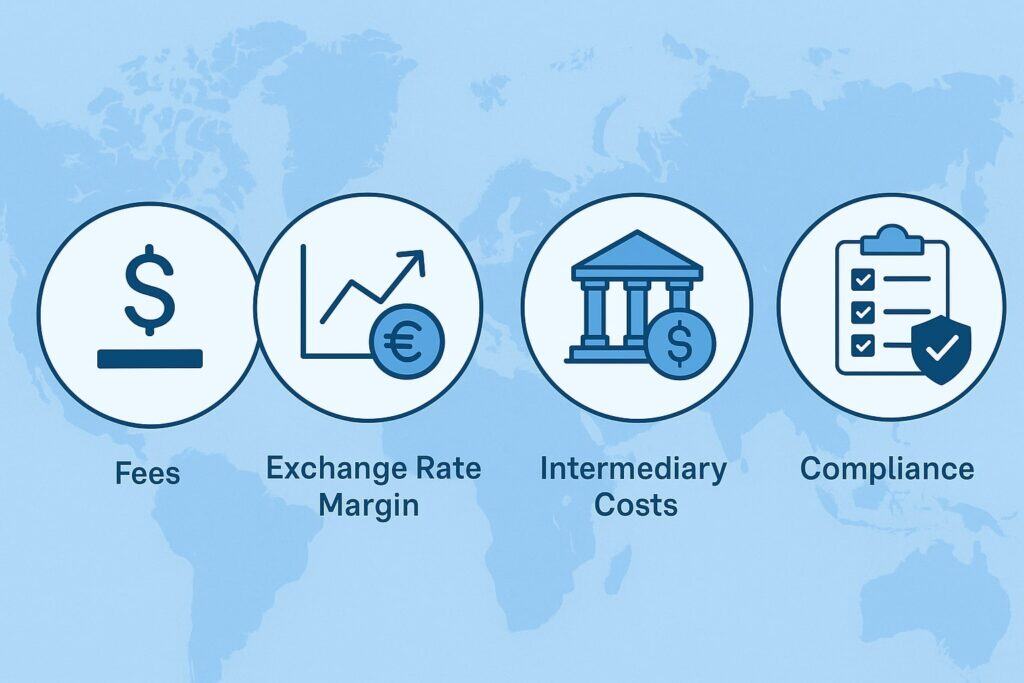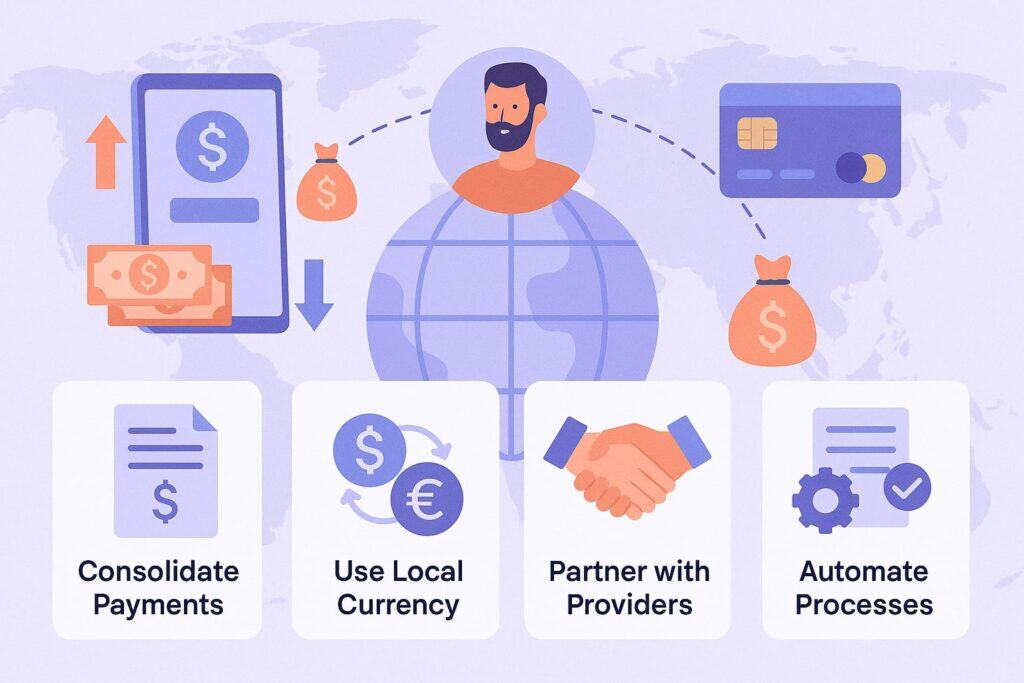
By crossborderfees September 27, 2025
Cross-border payment costs can be surprisingly high and opaque. Every time a business or individual sends money internationally, hidden fees and currency markups can erode the value of the transfer.
In fact, one study found that in 2023 U.S. consumers and small businesses paid $17.9 billion in international transaction fees, with 32% (about $5.8 billion) of that tied up in hidden currency exchange markups.
This article will break down each component of cross-border payment costs and show you how to calculate the true cost of moving money overseas. You’ll learn how banks and payment providers structure fees, why exchange rate spreads matter, and how fintech solutions can offer cheaper, more transparent alternatives to traditional banks.
Cross-border payments involve multiple steps and parties – each adding charges. You must consider not just the obvious wire fees, but also the currency conversion markup, intermediary bank charges, receiving fees, and even network or compliance costs.
By identifying every fee component and comparing quoted rates to the mid-market exchange rate, you can compute the actual dollars lost on a transaction. Below we outline the major cost drivers and provide a step-by-step method to tally them up for any international transfer.
Whether you’re a small business owner, a finance professional, or an individual sending money abroad, understanding these factors will help you see through the “junk fees” and calculate the true cross-border payment cost accurately.
Key Components of Cross-Border Payment Costs

Before calculating the total cost of a cross-border transfer, you need to identify each fee that can apply. In general, cross-border payment costs include:
- Currency conversion markup (Spread). This is the difference between the bank’s exchange rate and the mid-market (interbank) rate. Traditional banks typically add a markup of 2–4% (or more) above the mid-market rate.
In practice, if the interbank USD/EUR rate is 0.92, a bank might offer 0.89 – pocketing the 3% difference as profit. This invisible spread can cost hundreds on large transactions. - Foreign exchange (FX) fees. Some providers also charge an explicit FX processing fee or convenience fee (often 0.5–1%) on top of the spread.
For example, a bank might deliver a rate 3% worse than mid-market and still tack on a 1% FX fee, effectively charging over 4% in total for the conversion. - Flat wire or transfer fees. When sending money abroad (especially via SWIFT), banks impose fixed fees. Commonly, U.S. banks charge $25–$50 for an outgoing international wire and up to $30 for an incoming wire.
These charges apply per transfer regardless of amount; sending $100 or $100,000 incurs the same $25–$50 fee. - Intermediary (Correspondent) bank fees. If your payment is routed through one or more correspondent banks, each intermediate institution may deduct a fee (often $15–$50 each) before forwarding the funds.
The more hops in the SWIFT chain, the more fees accumulate. These fees are usually opaque until you see the SWIFT transaction record. - Receiving bank fees. The beneficiary’s bank may charge for crediting an international transfer (often a flat fee up to $10–$25) or convert the received currency, further reducing the amount delivered.
- Payment network and processor fees. For card-based cross-border payments, networks (Visa/Mastercard) and acquirers add their own charges. Typical credit card foreign-transaction fees run about 1–3% of the purchase amount (a combination of issuer and network fees).
Payment gateways or remittance services might also charge a percentage (often 1–2%) for handling an international payment. - Other costs and compliance fees. Some transfers incur extra fees for documentation, compliance (AML/KYC checks), or taxes.
For example, certain jurisdictions impose taxes or require export documentation on large payouts. These are usually small relative to the above charges but can appear on the fee ledger or exchange.
Each fee component compounds to increase the true cost. For instance, a single transaction can incur the sender’s wire fee, an intermediary fee, the receiver’s fee, the exchange-rate spread, and any percentage-based FX fee.
When summed, these hidden deductions often amount to 3–7% or more of the transaction value. In extreme cases, banks have added up to 150x more cost than the visible flat fee suggests.
How to Calculate the True Cost
Calculating the true cost means adding up every charge and figuring the effective loss on the transfer. Follow these steps to tally up the cost of a specific cross-border payment:
- Get the Mid-Market Rate: Identify the current interbank exchange rate (the mid-market rate). You can look this up on financial sites (e.g. XE.com, Google Finance, OANDA). This is your benchmark.
- Obtain the Quoted Rate: Ask your bank or provider what exchange rate they will use, or see it in the transaction confirmation. Many providers quote a rate that includes their margin.
- Calculate the FX markup: Use the formula Markup % = ((Bank Rate – Mid-Market Rate) / Mid-Market Rate) × 100.
For example, if the bank offers 0.89 USD/EUR while mid-market is 0.92, the markup is ((0.89 – 0.92)/0.92)×100 ≈ – 3.26% (meaning the bank’s rate is 3.26% worse than the interbank rate). - Convert to dollar cost: Multiply the markup percentage by your transfer amount to find how many dollars (or original currency) that spread costs you. In the above example, on $10,000 that 3.26% difference means about $326 lost to the poor rate.
- Calculate the FX markup: Use the formula Markup % = ((Bank Rate – Mid-Market Rate) / Mid-Market Rate) × 100.
- Tally Fixed Fees: Note any flat fees charged:
- Outgoing bank fee: e.g. $25–50 for a wire transfer.
- Incoming bank fee: e.g. $0–30 on the beneficiary’s side.
- Intermediary fees: Estimate $15–50 per correspondent (often 2–3 banks may apply a fee).
Sum these: e.g. sender $30 + 2 intermediaries $20 each + receiver $20 = $90 fixed fees.
- Outgoing bank fee: e.g. $25–50 for a wire transfer.
- Add Percentage Fees: If applicable, include any percentage-based fees:
- FX transaction fee: e.g. 1% of amount (some banks or services do this on top of spread).
- Card/network fee: if payment via card, ~1–3% of amount.
- FX transaction fee: e.g. 1% of amount (some banks or services do this on top of spread).
- Compute Net Amount: Subtract all fees from the original amount to estimate how much the beneficiary actually receives. You can do this stepwise:
- Subtract flat fees from the original amount.
- Apply the (worse) exchange rate to the remainder.
- Subtract any receiving bank fee or other deductions.
This tells you the final delivered funds. Alternatively, work backwards: ask what net rate is implied by the fees.
- Subtract flat fees from the original amount.
- Determine Overall Cost: The true cost of the payment is the difference between the original sent amount and the net amount received. In percentage terms, divide the total lost by the original. For example, if you sent $1,000 but fees and rate differences cost you $50 total, the true cost is 5%.
For clarity, here’s a simple example calculation:
- You want to send $5,000 USD to a partner in EUR. Mid-market rate USD→EUR is 0.90. Your bank offers 0.87.
- Calculate FX loss: Mid vs bank rate gives (0.90–0.87)/0.90 ≈ 3.33% worse. On $5,000, that’s about $167 lost to the spread.
- Wire fees: Bank charges $25 outgoing and beneficiary’s bank charges $15 incoming. Suppose one intermediary fee of $20. Total fixed = $60.
- Other fees: No extra percentage fees in this scenario.
- Total cost: $167 (spread) + $60 (flat fees) = $227. On a $5,000 transfer, that’s 4.54% total cost.
- If we consider the mid-market transfer, you’d expect €4,500. With the bank’s worst rate, you get €4,350 (because $5,000×0.87). The €150 difference is from the FX gap, plus about $60 in fees (≈€53) reduces it further.
This illustrates how an apparently small percentage spread becomes a significant dollar cost. By repeating this calculation for any transfer, you get the true cross-border payment cost.
Using the “OUR/SHA/BEN” Option
When wiring money, banks often ask who pays the fees (OUR, SHA, or BEN):
- OUR: Sender pays all fees (so you cover outgoing and all correspondents). Best for cost control if you want your recipient to get the full amount you intended.
- SHA (Shared): Sender pays the outgoing fee; receiver pays the incoming fee. Intermediate fees are split (often taken by intermediary).
- BEN: Beneficiary pays all fees (receiver gets less).
For calculating true costs, using OUR ensures the receiver’s bank won’t deduct a fee, and you’ll see all charges upfront. It may raise your sending fee, but it prevents unpredictable deductions on the recipient’s side. In any case, be aware of which option applies so you can add those fees appropriately.
Traditional Banks vs. Fintech Solutions

Traditional banks and modern fintech services differ greatly in how they charge for cross-border payments:
- Fees and Rates: Banks usually levy multiple fees (sending, receiving, intermediaries) and offer worse exchange rates (often 2–5% above mid-market). In contrast, fintech money-transfer services and specialist platforms aim for transparency.
Many use the actual mid-market rate and charge only a small, disclosed fee. For example, some digital providers advertise a single flat fee plus a low percentage markup (around 0.3–1%). - Example costs: In the U.S., a typical bank international wire might cost $25–50 outgoing (plus any $15–30 incoming). Fintech apps like Wise, Revolut or PayPal’s Xoom often charge much less (some offer first transfers for $0 or ~$5, and use fair exchange rates).
These services route payments through local rails or partner networks, avoiding most correspondent fees. As one analysis notes, “banks in the U.S. could charge as high as $50” per transfer, whereas Fintech platforms offer much lower fees and sometimes waive them on initial transfers. - Speed: Traditional SWIFT transfers can take 1–5 business days, incurring more time-zone and processing delays. Fintech and digital wallets often deliver within minutes or hours, which can also avoid market volatility in rates.
- Transparency: Banks often lump the FX margin into a hidden spread, making true cost unclearl. Fintech providers typically display the exact rate and fee before you send, so you can calculate costs up front.
For instance, a transparent platform may show you the mid-market rate and a single fee, so you immediately know how much the recipient will get. - Local accounts and rails: Many fintechs maintain local currency accounts worldwide, enabling local transfers rather than full foreign wires.
Sending USD to, say, Europe might use a U.S.-based domestic ACH to the fintech’s EU account, then a domestic Euro transfer – bypassing SWIFT altogether. This slashes correspondent and wire fees. Traditional banks rarely do this for small businesses or individuals. - Innovations: Some new services even use blockchain or DeFi rails to cut costs. For example, one fintech (Daniel Global) touts “DeFi payment rails” on a blockchain that remove intermediaries and offer ultra-low costs.
While not yet mainstream for all businesses, these emerging methods promise near-zero cross-border fees in the future by eliminating SWIFT and correspondent banks.
Strategies to Reduce Cross-Border Costs

Knowing how fees work, you can take steps to minimize your cross-border payment costs:
- Compare exchange rates: Always check the mid-market rate (via Google, XE, Bloomberg) and compare to the rate your provider offers.
Even a 1% difference on large transfers adds up. Some platforms (like Wise or Revolut) boast mid-market rates with a small, known markup. - Ask for fee breakdown: Require your bank or service to itemize all fees. Some institutions have migrated to transparency standards (e.g. ISO 20022) that should list fees clearly. If using SWIFT, you may get an MT103 SWIFT copy showing deductions.
- Batch payments: Instead of sending many small transfers, combine invoices into fewer large transfers. Since many fees are fixed per transfer, batching spreads that fixed cost over more funds.
The Trolley guide shows how batching 20 $500 payments (with 20×$15 wires) costs $300, whereas batching into 4 payments costs only $60. - Use local currency accounts: Hold balances in multiple currencies or partner with platforms that give you local bank details.
This lets you send money “locally” (e.g. ACH, SEPA) without any FX markup or SWIFT fees. Many fintech accounts provide virtual USD/EUR/GBP accounts for this. - Negotiate rates: If you send very large amounts, talk to your bank about lowering fees or getting a better exchange margin. Large corporate clients often get better pricing. Even some fintech providers will offer custom pricing for high-volume businesses.
- Set your bank’s instructions: Choose the fee option (OUR/SHA) strategically. Selecting OUR may cost more up front but ensures your recipient doesn’t lose part of the funds to hidden intermediary fees.
- Timing and hedging: Because exchange rates fluctuate, you can time large transfers when rates are favorable.
Some platforms allow automated transfers when a target rate is hit. Hedging instruments (forward contracts) can lock in rates for future needs, but involve additional cost and complexity. - Explore alternative rails: For example, some companies use blockchain networks or stablecoin transactions for business payments. These can reduce reliance on SWIFT and avoid correspondent fees, though they introduce new considerations (volatility, compliance).
- Leverage transparent fintech: Many modern remittance services break down all costs. Switching to a platform known for low-cost global payouts often yields immediate savings. As one comparison notes, fintech remittance apps are generally cheaper and faster than legacy bank wires.
By applying these strategies, businesses and individuals can significantly cut the true cost of cross-border payments, improving margins and cash flow.
Frequently Asked Questions (FAQs)
Q: Why are cross-border payments so much more expensive than domestic transfers?
A: Cross-border transfers involve many extra steps: currency conversion, international routing, and regulatory checks. Each adds potential fees. Banks charge for currency exchange with marked-up rates, plus wire fees on both ends.
There may be multiple correspondent banks involved. In contrast, domestic transfers (like ACH or Fedwire) often have minimal fees and no exchange. All these international factors – the “junk fees” – compound to make cross-border payments much pricier.
Q: What is the mid-market rate and why is it important?
A: The mid-market rate (also called interbank rate) is the midpoint between buy/sell rates in global forex markets – essentially the “true” currency rate used by banks trading with each other. It’s the rate you see on financial news sites.
Retail banks almost never give you the mid-market rate; they add a spread. By comparing the provider’s rate to the mid-market rate, you can calculate how much extra you are paying as a markup.
Q: How do I compute the exchange rate markup my bank charges?
A: Use the formula:
\text{Markup %} = \frac{\text{Mid-Market Rate} – \text{Bank’s Rate}}{\text{Mid-Market Rate}} \times 100.
Then multiply this percentage by the transaction amount. For example, if the mid-market USD/EUR is 0.90 and your bank offers 0.87, then markup = (0.90–0.87)/0.90 ≈ 3.33%. On $10,000, you’re losing $333 to the poor rate.
Q: What is an intermediary bank fee?
A: When your international payment goes through SWIFT, correspondent banks (intermediaries) handle the transfer between the sender’s and receiver’s banks. Each correspondent may take a fee (often $15–$50).
These are usually deducted invisibly. Your sender or receiver only finds out when the amount is short. The only way to minimize this is to use providers that avoid SWIFT (like some fintechs) or choose OUR fees so you see all deductions.
Q: Do fintech services really save money on cross-border transfers?
A: Often, yes. Fintech platforms like Wise, Revolut, PayPal Xoom, and others typically charge lower fees than banks. They use transparent pricing (mid-market rate + disclosed fee) and often leverage local payment networks.
Many offer no flat wire fee or a small one, versus banks’ $25+ fees. Also, fintech transfers can be much faster. According to industry analysis, consumers increasingly prefer digital apps because 53% surveyed use them for remittances and banks are losing market share to fintech.
However, always compare, as fintech may charge a small percentage fee – still generally below bank costs.
Q: Are credit card payments cheaper or more expensive than wire transfers?
A: Paying with a credit card abroad or for a cross-border purchase usually incurs a foreign transaction fee (typically 1–3% of the purchase). While that might seem low, if the purchase is large, the fee can exceed a flat wire fee.
Also, credit card transactions have their own FX markup (often hidden in the conversion). Sometimes it can be cheaper to do a bank wire for large sums. For small payments or consumer spending, cards are convenient, but always check for fees.
Q: How can I estimate the total cost before sending a transfer?
A: You can use online calculators (many currency apps or bank websites have them) to estimate fees. First, determine all known fees (wire charges, etc.) and get the provider’s exchange rate quote.
Subtract the provider’s rate from the mid-market rate to find the percentage spread. Multiply your amount by that percentage, then add any flat fees.
Alternatively, some platforms show you exactly how much the beneficiary will receive for a given amount – allowing you to back-calculate the cost. For accurate planning, always ask your provider for the full breakdown.
Q: What if I want my recipient to receive the exact amount I send?
A: To ensure full-value delivery, request an “OUR” transfer and account for all fees. If you specify OUR (sender pays all fees), the beneficiary should get the gross amount you sent (minus only the conversion spread).
For example, if you send 1,000 units USD and the recipient’s currency is Y, choose OUR and offer to pay any extra fees so that the beneficiary’s bank receives the full converted Y amount.
Alternatively, some services (like the Papaya platform) guarantee full-value delivery by design, meaning you agree to a slight markup but the recipient gets the full invoice amount in local currency.
Conclusion
Calculating the true cost of cross-border payments means looking beyond the headline fee and factoring in every deduction. Start by finding the mid-market exchange rate and comparing it to your bank or service’s rate to measure any hidden markup.
Then add fixed fees from sending, intermediaries, and receiving banks. Don’t forget card and network charges if you pay by credit card. When you tally all these together, you’ll see the real percentage of your transaction eaten by fees.
Compared to banks, fintech payment solutions often provide a clearer and cheaper pricing structure. By using local rails, transparent FX rates, and fewer intermediaries, these platforms can drastically cut cross-border costs.
Businesses and individuals in the U.S. can leverage these alternatives or negotiate with banks to reduce markups.
Ultimately, knowledge is power. By understanding each component—wire fees, FX spread, and so on—and using the steps above, you can calculate true cross-border payment costs accurately.
This will help you budget international transfers properly, avoid nasty surprises, and choose the most cost-effective transfer method for your needs.